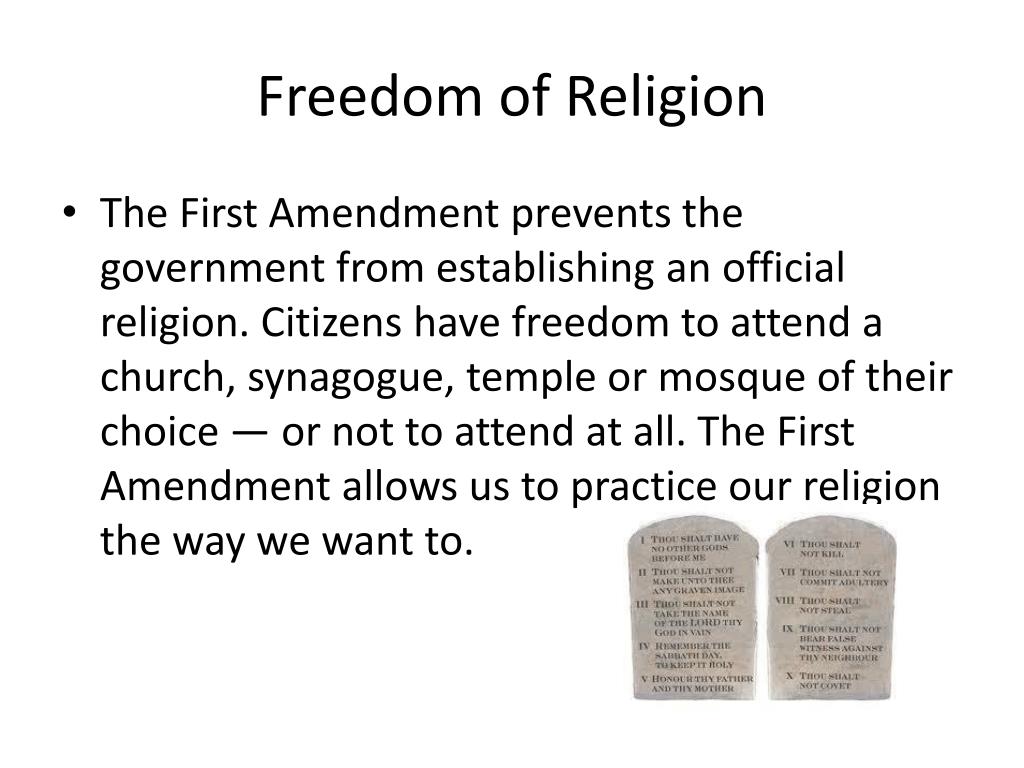

Supreme Court ruled that two large, framed copies of the Ten Commandments in Kentucky courthouses violated the First Amendment.We'll dive deeper into three of the most significant liberties of the First Amendment. Perry, the Supreme Court ruled that the display of a six-foot Ten Commandments monument at the Texas State Capital was constitutional.

Ten Commandments Cases (2005): In 2005, the Supreme Court came to seemingly contradictory decisions in two cases involving the display of the Ten Commandments on public property. This Supreme Court case established the “Lemon Test” for determining when a state or federal law violates the Establishment Clause-that’s the part of the First Amendment that prohibits the government from declaring or financially supporting a state religion. Kurtzman (1971): This Supreme Court decision struck down a Pennsylvania law allowing the state to reimburse Catholic schools for the salaries of teachers who taught in those schools. When she applied for unemployment compensation, a South Carolina court denied her claim. When her employer switched from a five-day to six-day workweek, she was fired for refusing to work on Saturdays. In this case, Adell Sherbert, a Seventh-day Adventist, worked in a textile mill. Verner (1963): The Supreme Court ruled that states could not require a person to abandon their religious beliefs in order to receive benefits. Brown (1961): The Supreme Court upheld a Pennsylvania law requiring stores to close on Sundays, even though Orthodox Jews argued the law was unfair to them since their religion required them to close their stores on Saturdays as well. The Supreme Court ruled that the First Amendment forbids government from regulating belief but not from actions such as marriage.īraunfeld v. United States (1878): This Supreme Court case tested the limits of religious liberty by upholding a federal law banning polygamy. Maryland, for instance, required “a declaration of belief in God,” for all state officeholders until 1961. While most states followed federal example and abolished religious tests for public office, some states maintained religious tests well into the twentieth century. At these schools, Native American children were prohibited from wearing ceremonial clothes or practicing native religions. government subsidized boarding schools to educate and assimilate Native American children. In the late nineteenth and early twentieth centuries, the U.S. Missouri governor Lilburn Boggs ordered that all Mormons be exterminated or expelled from the state.Īt Haun’s Mill, Missouri militia members massacred 17 Mormons on October 30, 1838. Mormons, led by Joseph Smith, clashed with the Protestant majority in Missouri in 1838. Religious Intolerance In the United States The Fourteenth Amendment, adopted in 1868, extended religious freedom by preventing states from enacting laws that would advance or inhibit any one religion.

It established a separation of church and state that prohibited the federal government from making any law “respecting an establishment of religion.” It also prohibits the government, in most cases, from interfering with a person’s religious beliefs or practices. The First Amendment was adopted on December 15, 1791. Madison would go on to draft the First Amendment, a part of the Bill of Rights that would provide constitutional protection for certain individual liberties including freedom of religion, freedom of speech and the press, and the rights to assemble and petition the government. In 1785, Virginia statesman (and future president) James Madison argued against state support of Christian religious instruction. This broke with European tradition by allowing people of any faith (or no faith) to serve in public office in the United States. The Constitution prohibits the use of religious tests as qualification for public office. Religion was mentioned only once in the U.S. Rhode Island became the first colony with no established church and the first to grant religious freedom to everyone, including Quakers and Jews.Īs Virginia’s governor in 1779, Thomas Jefferson drafted a bill that would guarantee the religious freedoms of Virginians of all faiths-including those with no faith-but the bill did not pass into law. Williams then moved south and founded Rhode Island. In 1635 Roger Williams, a Puritan dissident, was banned from Massachusetts.



 0 kommentar(er)
0 kommentar(er)
